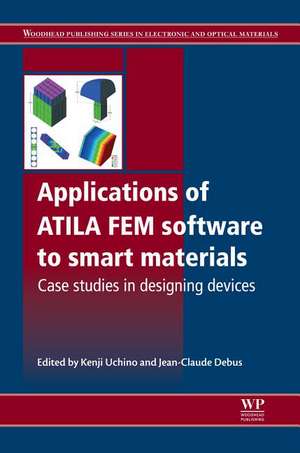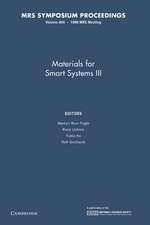Applications of ATILA FEM Software to Smart Materials: Case Studies in Designing Devices: Woodhead Publishing Series in Electronic and Optical Materials
Editat de Kenji Uchino, Jean-Claude Debusen Limba Engleză Hardback – 26 noi 2012
Part one provides an introduction to ATILA FEM software, beginning with an overview of the software code. New capabilities and loss integration are discussed, before part two goes on to present case studies of finite element modelling using ATILA. The use of ATILA in finite element analysis, piezoelectric polarization, time domain analysis of piezoelectric devices and the design of ultrasonic motors is considered, before piezo-composite and photonic crystal applications are reviewed. The behaviour of piezoelectric single crystals for sonar and thermal analysis in piezoelectric and magnetostrictive materials is also discussed, before a final reflection on the use of ATILA in modelling the damping of piezoelectric structures and the behaviour of single crystal devices.
With its distinguished editors and international team of expert contributors, Applications of ATILA FEM software to smart materials is a key reference work for all those involved in the research, design, development and application of smart materials, including electrical and mechanical engineers, academics and scientists working in piezoelectrics, magenetostrictors and shape memory materials.
- Provides an indispensable guide to the use of ATILA FEM software in the design of effective products
- Discusses new capabilities and loss integration of the software code, before presenting case studies of finite element modelling using ATILA
- Discusses the behaviour of piezoelectric single crystals for sonar and thermal analysis in piezoelectric and magnetostrictive materials, before a reflection on the use of ATILA in modelling the damping of piezoelectric structures
Din seria Woodhead Publishing Series in Electronic and Optical Materials
- 18%
 Preț: 2155.45 lei
Preț: 2155.45 lei - 24%
 Preț: 1160.66 lei
Preț: 1160.66 lei - 39%
 Preț: 1136.44 lei
Preț: 1136.44 lei - 9%
 Preț: 912.54 lei
Preț: 912.54 lei - 9%
 Preț: 956.68 lei
Preț: 956.68 lei - 24%
 Preț: 951.04 lei
Preț: 951.04 lei - 9%
 Preț: 1335.64 lei
Preț: 1335.64 lei - 29%
 Preț: 986.78 lei
Preț: 986.78 lei - 24%
 Preț: 874.56 lei
Preț: 874.56 lei - 29%
 Preț: 1075.95 lei
Preț: 1075.95 lei - 29%
 Preț: 1414.77 lei
Preț: 1414.77 lei - 9%
 Preț: 1216.61 lei
Preț: 1216.61 lei - 39%
 Preț: 811.62 lei
Preț: 811.62 lei - 29%
 Preț: 1193.77 lei
Preț: 1193.77 lei - 9%
 Preț: 1444.32 lei
Preț: 1444.32 lei - 24%
 Preț: 926.89 lei
Preț: 926.89 lei - 9%
 Preț: 1107.16 lei
Preț: 1107.16 lei - 9%
 Preț: 1262.45 lei
Preț: 1262.45 lei - 9%
 Preț: 954.69 lei
Preț: 954.69 lei - 9%
 Preț: 958.65 lei
Preț: 958.65 lei - 9%
 Preț: 948.72 lei
Preț: 948.72 lei - 9%
 Preț: 1150.61 lei
Preț: 1150.61 lei - 23%
 Preț: 1493.72 lei
Preț: 1493.72 lei - 9%
 Preț: 950.94 lei
Preț: 950.94 lei - 24%
 Preț: 1276.29 lei
Preț: 1276.29 lei - 29%
 Preț: 1333.73 lei
Preț: 1333.73 lei - 9%
 Preț: 901.22 lei
Preț: 901.22 lei - 9%
 Preț: 1130.18 lei
Preț: 1130.18 lei - 9%
 Preț: 1049.49 lei
Preț: 1049.49 lei - 24%
 Preț: 871.12 lei
Preț: 871.12 lei - 27%
 Preț: 1459.23 lei
Preț: 1459.23 lei - 20%
 Preț: 1071.49 lei
Preț: 1071.49 lei - 24%
 Preț: 932.11 lei
Preț: 932.11 lei - 29%
 Preț: 1071.64 lei
Preț: 1071.64 lei - 24%
 Preț: 670.36 lei
Preț: 670.36 lei - 9%
 Preț: 926.48 lei
Preț: 926.48 lei - 23%
 Preț: 929.43 lei
Preț: 929.43 lei - 9%
 Preț: 897.50 lei
Preț: 897.50 lei - 9%
 Preț: 1276.81 lei
Preț: 1276.81 lei - 9%
 Preț: 957.63 lei
Preț: 957.63 lei - 29%
 Preț: 845.10 lei
Preț: 845.10 lei - 9%
 Preț: 953.05 lei
Preț: 953.05 lei - 33%
 Preț: 1126.67 lei
Preț: 1126.67 lei - 29%
 Preț: 954.77 lei
Preț: 954.77 lei - 24%
 Preț: 961.16 lei
Preț: 961.16 lei - 23%
 Preț: 930.29 lei
Preț: 930.29 lei - 23%
 Preț: 1080.19 lei
Preț: 1080.19 lei
Preț: 1006.73 lei
Preț vechi: 1106.30 lei
-9% Nou
Puncte Express: 1510
Preț estimativ în valută:
192.63€ • 201.13$ • 159.43£
192.63€ • 201.13$ • 159.43£
Carte tipărită la comandă
Livrare economică 28 martie-11 aprilie
Preluare comenzi: 021 569.72.76
Specificații
ISBN-13: 9780857090652
ISBN-10: 0857090658
Pagini: 400
Dimensiuni: 156 x 234 x 27 mm
Greutate: 0.75 kg
Ediția:New.
Editura: ELSEVIER SCIENCE
Seria Woodhead Publishing Series in Electronic and Optical Materials
ISBN-10: 0857090658
Pagini: 400
Dimensiuni: 156 x 234 x 27 mm
Greutate: 0.75 kg
Ediția:New.
Editura: ELSEVIER SCIENCE
Seria Woodhead Publishing Series in Electronic and Optical Materials
Cuprins
Contributor contact details
Woodhead Publishing Series in Electronic and Optical Materials
Part I: Introduction to the ATILA finite element method (FEM) software
Chapter 1: Overview of the ATILA finite element method (FEM) software code
Abstract:
1.1 An introduction to finite element analysis
1.2 Defining the equations for the problem
1.3 Application of the finite element method (FEM)
1.4 Finite element method (FEM) simulation examples
1.5 Conclusion
Chapter 2: The capabilities of the new version of ATILA
Abstract:
2.1 Introduction
2.2 The new version of ATILA
2.3 Pre- and post-processor GiD
2.4 New capacities in ATILA/GiD
2.5 Time comparison between ATILA and ATILA++
2.6 Conclusion
Chapter 3: Loss integration in ATILA software
Abstract:
3.1 Introduction: nonlinear and hysteresis characteristics
3.2 Heat generation
3.3 Hysteresis estimation program
3.4 Conclusion
Part II: Case studies of finite element modelling using ATILA
Chapter 4: Finite element analysis of flexural vibration of orthogonally stiffened cylindrical shells with ATILA
Abstract:
4.1 Introduction
4.2 Shell formulation
4.3 Stiffened shell finite element
4.4 Validation
4.5 Conclusion
Chapter 5: Utilization of piezoelectric polarization in ATILA: usual to original
Abstract:
5.1 Introduction
5.2 Piezoelectric effect
5.3 Utilization of the Cartesian polarization: Cartesian coordinates
5.4 Utilization of the Cartesian polarization: cylindrical coordinates
5.5 Utilization of the cylindrical polarization: cylindrical coordinates
5.6 Original polarization
Conclusion
5.7 Conclusion
Chapter 6: Time domain analysis of piezoelectric devices with the transient module in ATILA
Abstract:
6.1 Introduction
6.2 Key design issues and parameters
6.3 Step-by-step use of ATILA transient module
6.4 Conclusion and future trends
Chapter 7: Designing ultrasonic motors (USM) with ATILA
Abstract:
7.1 Introduction
7.2 Procedure for finite element method (FEM) analysis – ATILA
7.3 Tiny ultrasonic motor (USM)
7.4 Butterfly-shaped ultrasonic linear motor
7.5 Conclusions
Chapter 8: Piezocomposite applications of ATILA
Abstract:
8.1 Introduction
8.2 General formulation
8.3 Transmission coefficient of an Alberich coating
8.4 1–3 piezocomposite
8.5 Conclusion
Chapter 9: Phononic crystal (PC) applications of ATILA
Abstract:
9.1 Introduction
9.2 General formulation
9.3 Phononic crystals for guiding applications
9.4 Phononic crystals for negative refraction applications
9.5 Conclusion
Chapter 10: Studying the behavior of piezoelectric single crystals for sonar using ATILA
Abstract:
10.1 Introduction
10.2 State of the art single crystal technology
10.3 Modeling the behavior of single crystal materials using ATILA software
10.4 The experiment
10.5 Analysis of results
10.6 The analytic model
10.7 Conclusion
10.8 Acknowledgments
Chapter 11: Thermal analysis in piezoelectric and magnetostrictive materials using ATILA
Abstract:
11.1 Introduction
11.2 Heat generation in piezoelectric materials
11.3 Implementation of ATILA for the thermal analysis of piezoelectric materials
11.4 Strains and stresses in piezoelectric materials caused by thermal effects
11.5 Numerical validation of the model
11.6 Experimental validation of the model
11.7 Heat generation in magnetostrictive materials
11.8 Temperature in an internal cavity in a magnetostrictive transducer
11.9 Conclusion
Chapter 12: Modelling the damping of piezoelectric structures with ATILA
Abstract:
12.1 Introduction
12.2 Circuit coupled simulation method
12.3 Semi-active damping method
12.4 Applications
Chapter 13: Modelling the behaviour of single crystal devices with ATILA: the effect of temperature and stress on a single crystal bar, tonpilz and sphere submitted to a harmonic analysis
Abstract:
13.1 Introduction
13.2 Single crystal dependence
13.3 Non-linear analysis
13.4 Harmonic analysis of a length expander bar with parallel field
13.5 Harmonic analysis of a single crystal tonpilz transducer
13.6 Harmonic analysis of a single crystal bar with a bolt
13.7 Harmonic analysis of a single crystal thin sphere in air
13.8 Harmonic analysis of a single crystal thin shell in water: an analytical solution
13.9 Conclusion
Index
Woodhead Publishing Series in Electronic and Optical Materials
Part I: Introduction to the ATILA finite element method (FEM) software
Chapter 1: Overview of the ATILA finite element method (FEM) software code
Abstract:
1.1 An introduction to finite element analysis
1.2 Defining the equations for the problem
1.3 Application of the finite element method (FEM)
1.4 Finite element method (FEM) simulation examples
1.5 Conclusion
Chapter 2: The capabilities of the new version of ATILA
Abstract:
2.1 Introduction
2.2 The new version of ATILA
2.3 Pre- and post-processor GiD
2.4 New capacities in ATILA/GiD
2.5 Time comparison between ATILA and ATILA++
2.6 Conclusion
Chapter 3: Loss integration in ATILA software
Abstract:
3.1 Introduction: nonlinear and hysteresis characteristics
3.2 Heat generation
3.3 Hysteresis estimation program
3.4 Conclusion
Part II: Case studies of finite element modelling using ATILA
Chapter 4: Finite element analysis of flexural vibration of orthogonally stiffened cylindrical shells with ATILA
Abstract:
4.1 Introduction
4.2 Shell formulation
4.3 Stiffened shell finite element
4.4 Validation
4.5 Conclusion
Chapter 5: Utilization of piezoelectric polarization in ATILA: usual to original
Abstract:
5.1 Introduction
5.2 Piezoelectric effect
5.3 Utilization of the Cartesian polarization: Cartesian coordinates
5.4 Utilization of the Cartesian polarization: cylindrical coordinates
5.5 Utilization of the cylindrical polarization: cylindrical coordinates
5.6 Original polarization
Conclusion
5.7 Conclusion
Chapter 6: Time domain analysis of piezoelectric devices with the transient module in ATILA
Abstract:
6.1 Introduction
6.2 Key design issues and parameters
6.3 Step-by-step use of ATILA transient module
6.4 Conclusion and future trends
Chapter 7: Designing ultrasonic motors (USM) with ATILA
Abstract:
7.1 Introduction
7.2 Procedure for finite element method (FEM) analysis – ATILA
7.3 Tiny ultrasonic motor (USM)
7.4 Butterfly-shaped ultrasonic linear motor
7.5 Conclusions
Chapter 8: Piezocomposite applications of ATILA
Abstract:
8.1 Introduction
8.2 General formulation
8.3 Transmission coefficient of an Alberich coating
8.4 1–3 piezocomposite
8.5 Conclusion
Chapter 9: Phononic crystal (PC) applications of ATILA
Abstract:
9.1 Introduction
9.2 General formulation
9.3 Phononic crystals for guiding applications
9.4 Phononic crystals for negative refraction applications
9.5 Conclusion
Chapter 10: Studying the behavior of piezoelectric single crystals for sonar using ATILA
Abstract:
10.1 Introduction
10.2 State of the art single crystal technology
10.3 Modeling the behavior of single crystal materials using ATILA software
10.4 The experiment
10.5 Analysis of results
10.6 The analytic model
10.7 Conclusion
10.8 Acknowledgments
Chapter 11: Thermal analysis in piezoelectric and magnetostrictive materials using ATILA
Abstract:
11.1 Introduction
11.2 Heat generation in piezoelectric materials
11.3 Implementation of ATILA for the thermal analysis of piezoelectric materials
11.4 Strains and stresses in piezoelectric materials caused by thermal effects
11.5 Numerical validation of the model
11.6 Experimental validation of the model
11.7 Heat generation in magnetostrictive materials
11.8 Temperature in an internal cavity in a magnetostrictive transducer
11.9 Conclusion
Chapter 12: Modelling the damping of piezoelectric structures with ATILA
Abstract:
12.1 Introduction
12.2 Circuit coupled simulation method
12.3 Semi-active damping method
12.4 Applications
Chapter 13: Modelling the behaviour of single crystal devices with ATILA: the effect of temperature and stress on a single crystal bar, tonpilz and sphere submitted to a harmonic analysis
Abstract:
13.1 Introduction
13.2 Single crystal dependence
13.3 Non-linear analysis
13.4 Harmonic analysis of a length expander bar with parallel field
13.5 Harmonic analysis of a single crystal tonpilz transducer
13.6 Harmonic analysis of a single crystal bar with a bolt
13.7 Harmonic analysis of a single crystal thin sphere in air
13.8 Harmonic analysis of a single crystal thin shell in water: an analytical solution
13.9 Conclusion
Index









